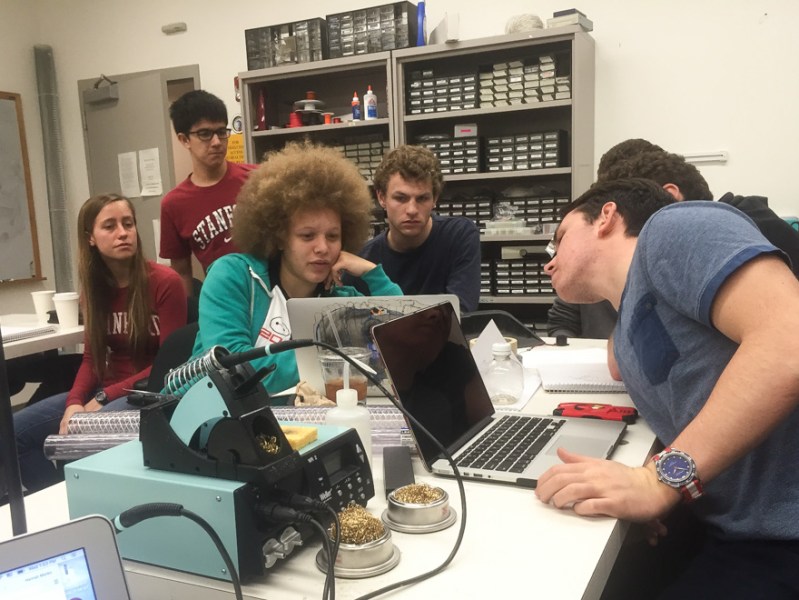The Introductory Seminar EE 27N: “Electronics Rocks” brings 16 freshmen together to conceive and build a single electrical engineering project as a class — a feat of both technical skills and teamwork.
Professor of electrical engineering Gregory Kovacs M.D. ’85 Ph.D. ’90, who has taught the course for five years now, said the class teaches students how to turn a project from idea into reality while also teaching the group mentality he believes is essential to engineering.

Kovacs recounted asking his EE 27N students if they had worked on a group project yet at Stanford. To his surprise, none of them had. For Kovacs, Stanford is the perfect incubator for a collaborative approach.
“The top kid at XYZ high school is an average kid at Stanford, usually,” Kovacs said. “So students go from one mode of ‘mostly about me’ to…‘let’s put our ideas together and synthesize.’”
After weeks of discussion, the class has settled on a general idea for their quarter-long project. Inspired by Stanford’s drought-motivated decision to turn off its fountains, the students are designing an interactive digital art piece that will use LEDs to evoke a water display.
Earlier contending ideas included clothing with integrated electronics and a floor that would interact with passersby and trace their movement.
Class projects from previous quarters have ranged widely. Last year, EE 27N created an interactive representation of the human body that displayed virtual cross-sections. Another year, students built a set of remote-controlled juggling balls that could produce optical illusions.
EE 27N spent last Wednesday on the details of their design, debating such issues as the presence of a centerpiece and how abstract their aesthetic should be. Hand-raising was minimal; instead, students chimed in organically with ideas and concerns.
One student brought out drawings, while another showed the class a model of the light display that he had created from boba tea straws. As the end of class neared, students put their competing ideas to a vote.
Throughout all this, Kovacs maintained a light presence, letting the students talk themselves toward consensus. He helped guide the conversation with questions: Did they want the display to interact differently with each viewer? What issues should they resolve today? Did anyone who hadn’t spoken yet have something to add?
“I was surprised by the amount of freedom Greg gave us in terms of deciding a project,” said Xochitl Longstaff ’19.
Longstaff compared the class to the more structured experience of her high school robotics team, which had an assigned task to complete.
“[Kovacs] was just like, go and pick something, and so that was a really daunting task,” Longstaff said. “But it’s also been really fun.”
Longstaff was drawn to the course’s combination of engineering and art — a meld that also excites Kovacs.
After listening to his students talk back and forth about the aesthetics of their proposed light display, Kovacs remarked, “I love the fact that these people who probably did AP Computer Science are now thinking like artists.”
Although many of the students have previous experience with electronics, Kovacs strives for a balance of different intellectual backgrounds. While looking through the hundred or so application essays he received from students who wanted to take the class, he tried to pick people that would work well together.
Kovacs, who described EE 27N as his favorite course to teach, said he enjoys watching the group of strangers that arrive on day one turn into familiar collaborators.
The next challenge for EE 27N will be delineating each class member’s responsibilities, and then, of course, beginning to build. The students plan to divide into an aesthetics team, a coding team and an electronics team.
“Greg wants us to do things that we’re not necessarily good at already or that wouldn’t be our natural choice,” explained Michael Hazard ’19.
At the end of the quarter, the students will demo their creation on campus for parents and friends.
“That notion that they can cook up an idea, reach consensus and bring that to some physical realization is empowering,” Kovacs said.
Contact Hannah Knowles at hknowles ‘at’ stanford.edu.
